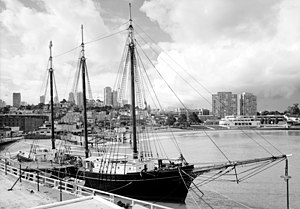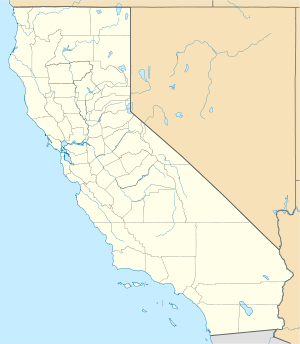
Star of India is an iron-hulled sailing ship, built in 1863 in Ramsey, Isle of Man as the full-rigged ship Euterpe. After a career sailing from Great Britain to India and New Zealand, she was renamed, re-rigged as a barque, and became a salmon hauler on the Alaska to California route. Retired in 1926, she was restored as a seaworthy museum ship in 1962–3 and home-ported at the Maritime Museum of San Diego in San Diego, California. She is the oldest ship still sailing regularly and also the oldest iron-hulled merchant ship still afloat. The ship is both a California Historical Landmark and United States National Historic Landmark.

Falls of Clyde is the last surviving iron-hulled, four-masted full-rigged ship, and the only remaining sail-driven oil tanker. Designated a U.S. National Historic Landmark in 1989, she is now a museum ship in Honolulu, but her condition has deteriorated. She is currently not open to the public. In September 2008, ownership was transferred to a new nonprofit organization, the Friends of Falls of Clyde. Efforts to raise $1.5 million to get the ship into drydock did not succeed. In November 2021 HDOT accepted a bid from Save Falls of Clyde – International (FOCI) to transport the ship to Scotland for restoration.
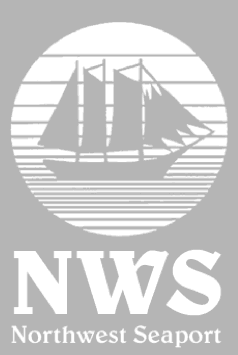
Northwest Seaport Maritime Heritage Center is a nonprofit organization in Seattle, Washington dedicated to the preservation and interpretation of Puget Sound and Northwest Coast maritime heritage, expressed through educational programs and experiences available to the public aboard its ships. The organization owns three large historic vessels docked at the Historic Ships' Wharf in Seattle's Lake Union Park; the tugboat Arthur Foss (1889), Lightship 83 Swiftsure (1904), and the halibut fishing schooner Tordenskjold (1911). These vessels are used as platforms for a variety of public programs, ranging from tours and festivals to restoration workshops and vocational training.

Balclutha, also known as Star of Alaska, Pacific Queen, or Sailing Ship Balclutha, is a steel-hulled full-rigged ship that was built in 1886. She is representative of several different commercial ventures, including lumber, salmon, and grain. She is a U.S. National Historic Landmark and is currently preserved at the San Francisco Maritime National Historical Park in San Francisco, California. She was added to the National Register of Historic Places on 7 November 1976.

The San Francisco Maritime National Historical Park is located in San Francisco, California, United States. The park includes a fleet of historic vessels, a visitor center, a maritime museum, and a library/research facility. Formerly referred to as the San Francisco Maritime Museum, the collections were acquired by the National Park Service in 1978. The San Francisco Maritime National Historical Park was authorized in 1988; the maritime museum is among the park's many cultural resources. The park also incorporates the Aquatic Park Historic District, bounded by Van Ness Avenue, Polk Street, and Hyde Street.

Alma is an 1891-built scow schooner, which is now preserved as a National Historic Landmark at the San Francisco Maritime National Historical Park in San Francisco, California.
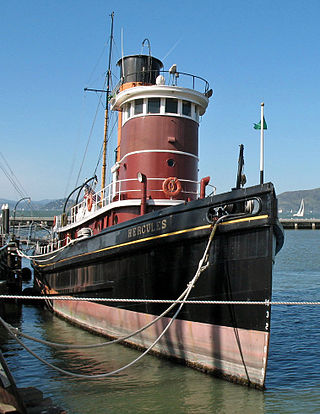
Hercules is a 1907-built steam tugboat that is now preserved at the San Francisco Maritime National Historical Park in San Francisco, California.

The tall ship Elissa is a three-masted barque. She is based in Galveston, Texas, and is one of the oldest ships sailing today. Launched in 1877, she is now a museum ship at the Texas Seaport Museum. She was designated a National Historic Landmark in 1990. The Texas Legislature designated Elissa the official tall ship of Texas in 2005.

Wawona was an American three-masted, fore-and-aft schooner that sailed from 1897 to 1947 as a lumber carrier and fishing vessel based in Puget Sound. She was one of the last survivors of the sailing schooners in the West Coast lumber trade to San Francisco from Washington, Oregon, and Northern California.
The West Coast lumber trade was a maritime trade route on the West Coast of the United States. It carried lumber from the coasts of Northern California, Oregon, and Washington mainly to the port of San Francisco. The trade included direct foreign shipment from ports of the Pacific Northwest and might include another product characteristic of the region, salmon, as in the schooner Henry Wilson sailing from Washington state for Australia with "around 500,000 feet of lumber and canned salmon" in 1918.

Bowdoin is a historic schooner built in 1921 in East Boothbay, Maine, at the Hodgdon Brothers Shipyard. Designed by William H. Hand, Jr. under the direction of explorer Donald B. MacMillan, the gaff-rigged vessel is the only American schooner built specifically for Arctic exploration. She has made 29 trips above the Arctic Circle in her life, three since she was acquired by the Maine Maritime Academy as a sail training ship in 1988. She is currently owned by the Academy, located in Castine, Maine, and is named for Bowdoin College.

Lettie G. Howard, formerly Mystic C and Caviare, is a wooden Fredonia schooner built in 1893 in Essex, Massachusetts, USA. This type of craft was commonly used by American offshore fishermen, and is believed to be the last surviving example of its type. She was declared a National Historic Landmark in 1989. She is now based at the South Street Seaport Museum in New York City.
Metha Nelson was built as a wooden‑hulled merchant schooner which was later used in historic movies as a full-rigged ship. During World War II, she served the United States Navy.

Wapama, also known as Tongass, was a vessel last located in Richmond, California. She was the last surviving example of some 225 wooden steam schooners that served the lumber trade and other coastal services along the Pacific Coast of the United States. She was managed by the National Park Service at San Francisco Maritime National Historical Park until dismantled in August 2013.

Grace Bailey, also known for many years as Mattie, is a two-masted schooner whose home port is Camden Harbor, Camden, Maine. Built in 1882 in Patchogue, New York, she is one of four surviving two-masted wooden-hulled schooners, once the most common vessel in the American coasting trade. She was one of the first ships in the fleet of historic vessels known as "Maine windjammers", which offer cruises in Penobscot Bay and the Maine coast, entering that service in 1939. She last underwent major restoration in 1989–90. She was declared a National Historic Landmark in 1992.

Lewis R. French is a gaff-rigged topsail schooner sailing out of Camden, Maine as a "Maine windjammer" offering 3 to 6 night cruises to tourists. Built in 1871, she is the oldest known two-masted schooner in the United States, and one of a small number of this once-common form of vessel in active service. The ship was designated a US National Historic Landmark in 1992.
Fairhaven is an unincorporated community and census-designated place (CDP) adjacent to Humboldt Bay in Humboldt County, California, United States. It is located 2.25 miles (3.6 km) west-southwest of downtown Eureka, at an elevation of 10 feet (3.0 m) above sea level.

Hans Ditlev Bendixsen was a Danish-American shipbuilder who was instrumental in the development of the merchant marine industry on the West Coast of the United States. His lumber schooners were built in or near Eureka, California in shipyards on Humboldt Bay for over 30 years. These schooners played a major role in the historic west coast lumber trade.
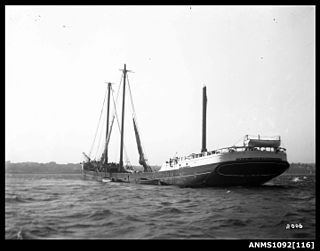
The Inca was "the first true five-masted schooner built on the West Coast."
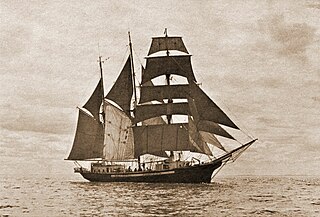
The sailing ship Regina Maris was originally built as the three-masted topsail schooner Regina in 1908. She was a 144-foot (44-meter), wooden, completely fore-and-aft–rigged sailing ship with three masts. She was re-rigged in 1963 as a 148-foot (45-meter) barquentine. Regina Maris could reach a speed of up to 12 knots, especially on a half-wind course or with a fresh back-stay breeze.
